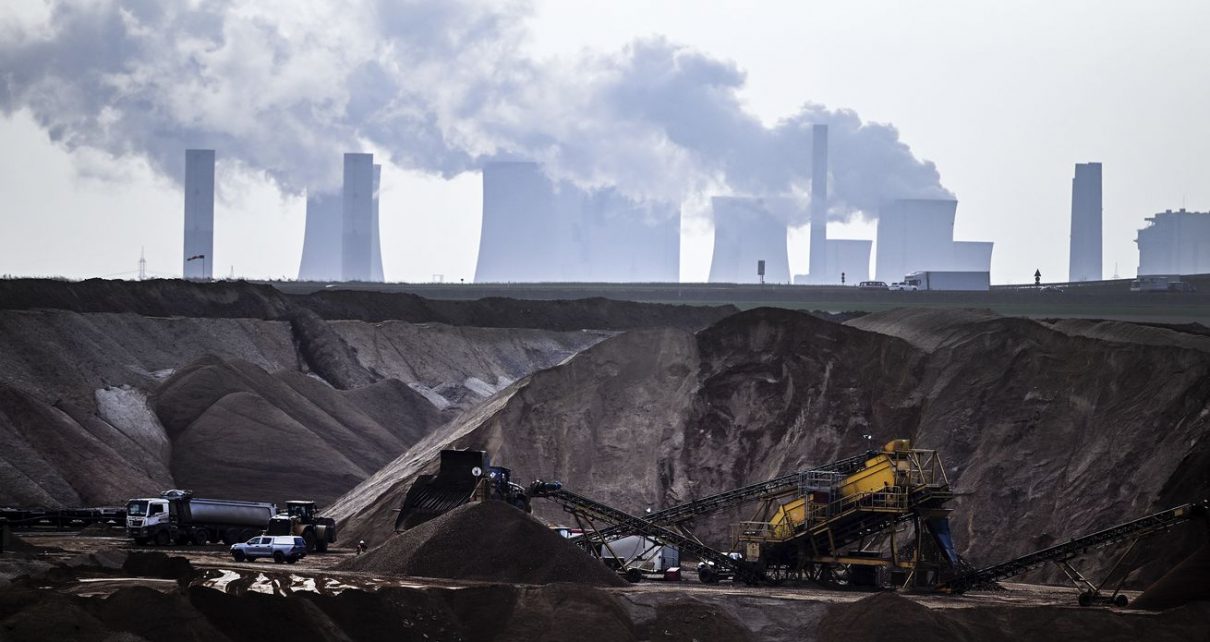
The latest UN climate report suggests the world has to end new fossil fuel infrastructure to meet current goals.
The world is on track to shoot far past climate change targets unless countries make drastic cuts in greenhouse gas emissions as soon as possible. Fortunately, many of the tools to make these cuts are already here and are continuing to get cheaper. Yet the pledges to lower emissions that countries have made so far are nowhere near enough, and the world is drifting even further off course.
These are some of the conclusions in the latest report of the United Nations’ independent scientific body, the Intergovernmental Panel on Climate Change. The massive 3,000-page document published Monday is a comprehensive review of the latest science on what it would actually take to mitigate climate change and avoid the most devastating scenarios of warming, and the ensuing chaos.
The report is the third installment of the IPCC’s Sixth Assessment Report, coming eight years after the last round of research reviews. It zeroes in on a fundamental question: What’s in our power to stop the heat-trapping emissions that come from burning fossil fuels?
The answer: There is a lot in our power, even down to the individual level. Readily available technology across the economy could slash pollution in half by 2030, but it depends more on the level of political will to implement these changes.
The planet has already warmed by more than 1 degree Celsius from burning fossil fuels, enough to begin causing havoc in every part of the globe. These changes are already testing the limits of habitation for millions of people who now face unbearable heat, disaster, drought, and flooding. The actions we take now and over the next eight years will be key in deciding how much worse warming gets this century.
One way to look at the latest IPCC report is as a blueprint for how countries can shift course and aggressively tackle rising emissions across their economies. Another way to see it is as a reminder of broken promises from rich nations that promised ambitious action but are still doing too little to contain pollution. The report notes that as much as 45 percent of global emissions comes from the top 10 percent of households, while the bottom 50 percent contribute about 15 percent of emissions.
“It is a file of shame, cataloging the empty pledges that put us firmly on track towards an unlivable world,” said United Nations Secretary-General António Guterres in a speech Monday.
The IPCC process reflects the consensus of thousands of scientists from around the world, but stops short of prescribing exact policies for lawmakers to follow. The report was delayed Monday because of political disputes over how to word the document’s stark findings and some of the language around drawing down fossil fuels.
Fractions of degrees — the difference between 1.5 degrees Celsius above pre-industrial times and 2 degrees Celsius — could make global warming far more destructive. Governments have promised to keep us under these levels, but the world is far away from these targets, and moving farther away every year.
In the most ambitious scenario of limiting warming to around 1.5°C, the report concluded, global carbon dioxide emissions would need to peak in the next three years, and fall by nearly half in the next eight. It means most of the world would need to start to abandon existing fossil fuel infrastructure in the next decade, and also nix any new and existing coal-fired power plants and plans to expand offshore oil drilling. And action must cut across sectors, addressing gas-guzzling transportation, heat-intensive manufacturing operations, and deforestation.
Over thousands of pages, the 278 IPCC authors look at an expansive range of places to tackle pollution, including the energy, transportation, and industry sectors, and examine how consumption patterns, technology, global finance, and politics can help and hinder global climate goals.
Continued fossil fuel infrastructure locks in the worst fate for climate change
In its most blunt terms ever, the IPCC warns that fossil fuels must be phased out to avoid worse warming. The report’s 64-page summary for policymakers concludes that projected carbon dioxide emissions “over the lifetime of existing and currently planned fossil fuel infrastructure” would ensure the world overshoots the 1.5°C target.
This is the closest the IPCC gets to a warning for policymakers about continuing to invest in fossil fuel infrastructure. Containing global warming means that the world will have to leave substantial fossil fuel resources unburned. It translates into $1 trillion to $4 trillion in untapped infrastructure, and even more if the world were serious about limiting warming to 1.5°C.
Coal infrastructure and investments would be the worst off. By 2050, almost the entirety of coal use would need to be phased out. “Coal assets are projected to be at risk of being stranded before 2030, while oil and gas assets are projected to be more at risk of being stranded toward mid-century,” the report states.
Solar and wind investments are the least expensive and most effective action we can take
The power sector is the single biggest driver of global climate pollution. It’s also the most important part of the economy to decarbonize as fast as possible. As the power grid becomes cleaner, then the cars, buses, and buildings that are increasingly powered by electricity also run on renewables instead of running on coal, oil, and gas.
While wind and solar are still a relatively small portion of the power sector at 8 percent of installed electricity, their falling costs make renewables a bright spot in the IPCC report for cleaning up pollution from the power sector.
This is an important distinction from the last time the IPCC looked at this topic in 2014.
Back in 2014, when the IPCC last published a comprehensive report on climate mitigation, wind, solar, and lithium-ion batteries were all more expensive than they are today. The IPCC left room for a future that would include fossil fuels as a major part of the energy mix. The most controversial policy it suggested was the need for the power sector to use an expensive technology that captures carbon dioxide at the power plant to prevent it from heating up the atmosphere. This process, known as carbon capture and storage, is controversial because it gives fossil fuels a lifeline and prolongs the world’s dependence on them. There are also no cost-effective examples of CCS working at a large scale.
Since 2010, the costs for wind energy have dropped by 55 percent, and by 85 percent for solar energy and lithium-ion batteries.
/cdn.vox-cdn.com/uploads/chorus_asset/file/23366753/Screen_Shot_2022_04_04_at_1.54.35_PM.png) IPCC report
IPCC report In light of these falling costs, the IPCC notes that by the end of the decade, it would be possible to run a power sector almost entirely on clean energy instead of fossil fuels. It won’t happen on its own. Governments still invest more in fossil fuels than renewable energy. Ending fossil-fuel subsidies alone could reduce global emissions by as much as 10 percent by 2030, the report notes.
Agriculture, industry, and parts of the transportation sector remain toughest to decarbonize
While most greenhouse gas emissions come from energy production, the remaining sources are still significant and are among the most challenging to reduce. The report shows that in the scenarios that keep warming below 2°C, most fossil fuel-related emissions will come from outside of the power sector.
According to the IPCC, about 34 percent of global emissions currently come from energy producers, 24 percent from industry, 15 percent from transportation, and 6 percent from buildings. Agriculture, forestry, and changes in land use account for 22 percent of global emissions.
Part of the challenge is that these other sources are often small, spread out, and owned by many individual private owners, while power plants are large, centralized facilities, governed by states and companies. That makes it harder to scale up interventions to cut emissions. In addition, making materials like chemicals and metals produces greenhouse gases beyond just the energy they use. Coal, for instance, is used to make coke, a vital fuel and reducing agent for making steel.
The report notes that for many of these industrial emitters, there are new low- and zero-emissions alternatives that are coming on the market, but they need a boost from policymakers.
At the same time, materials like cement also inherently produce greenhouse gases. Every pound of concrete made with cement emits about 0.93 pounds of carbon dioxide. Producers may have no choice but to use carbon capture and storage systems, or to use less of the material altogether. “Until new chemistries are mastered, deep reduction of cement process emissions will rely on already commercialised cementitious material substitution and the availability of CCS,” reads the report.
In transportation, the world has made progress in decarbonizing cars and trucks, and now there are multiple technologies that pave the way toward zero-emissions versions of these vehicles. However, the largest vehicles on earth — ships and aircraft — remain a massive technical challenge. There are no alternatives to fossil fuels that provide the needed energy density to cross continents and oceans. And the demand for these forms of transport is poised to grow.
The IPCC report says that biofuels and hydrogen may be the most promising clean technologies for shipping and aviation, but also noted that some of these emissions may never be abated completely. That means some form of carbon dioxide removal would be necessary to zero out the remaining emissions from these vehicles.
There are other pollutants besides carbon dioxide we have to worry about
Keeping climate change in check demands solving several problems at once. It’s not just carbon dioxide that’s the main concern for scientists anymore, but also other powerful greenhouse gas pollutants that make up a smaller portion of the atmosphere. These include dangerous pollutants like hydrofluorocarbons, commonly used in air conditioning, and nitrous oxide, used in medical procedures. But the pollutant that’s rising the fastest and is the second-biggest contributor to warming behind carbon dioxide is methane, the main component of natural gas.
The IPCC report published last fall singled out methane for its role in speeding up global warming. This latest report singles out methane again, but this time focuses on how slashing excess methane emissions from the energy sector plays an important role in containing climate change.
Methane comes from a wide range of sources, like agriculture, landfills, and natural gas drilling. The IPCC notes that between 50 and 80 percent of methane coming from drilling operations and pipelines could be avoided by installing readily available, low-cost technology that monitors and contains leaks.
Politics, not technology, will determine the course of climate change
The IPCC likes to say that its reports are relevant to policymakers, but they aren’t prescriptive. Yet the latest report shows that if world leaders are serious about limiting warming this century, there are only a handful of options that will deliver results in time.
However, the biggest uncertainty isn’t what technologies will be most viable or cost-effective this decade, but what politicians will do with this information.
“Every country must move further and faster,” John Kerry, Biden’s top climate envoy, said in a statement. “Faster means rapidly upscaling deployment of renewable energy. Faster means targeting methane emissions. Faster means reducing demand and focusing on efficiency. Faster means halting and reversing global deforestation. Faster means demanding more sustainable transit.”
The world isn’t moving faster, though. In fact, countries are retreating on climate pledges. Major polluters, including the European Union and the United States, are reconfiguring energy plans due to the disruption in supplies caused by Russia’s war on Ukraine. Russia has already indicated it will backtrack from its commitments to climate action in light of sanctions on its oil and gas exports. Meanwhile, the Biden administration and Europe are eyeing new gas terminals to make up for Russian exports.
But the impacts of climate change don’t break for war; in many ways, the effects of climate change compound the challenges. For example, a warming world risks widespread drought and crop failures. The war is likely only to exacerbate these effects. Russia’s exports of fertilizer may be affected, alongside Ukraine’s exports of grains.
The biggest question for climate change is not what technologies will break through, but what decision makers will do — not just national governments, but the response from cities and local leaders can shape the course the world takes.
In the run-up to last year’s global climate conference in Glasgow, “there was a lot of tremendous action,” said Pete Ogden, vice president for energy, climate, and the environment at the UN Foundation. “You need to then internalize it and realize it’s not enough. We are nowhere on a glide path here to successfully averting climate disasters.” At next fall’s UN conference in Egypt, countries will have another chance to follow through on the IPCC report, especially by ramping up global finance to fill the gap in funding for clean energy projects.
The latest IPCC report highlights that there are a variety of tools available to meet international climate goals. But they aren’t easy or cheap to deploy, and time is running out.





